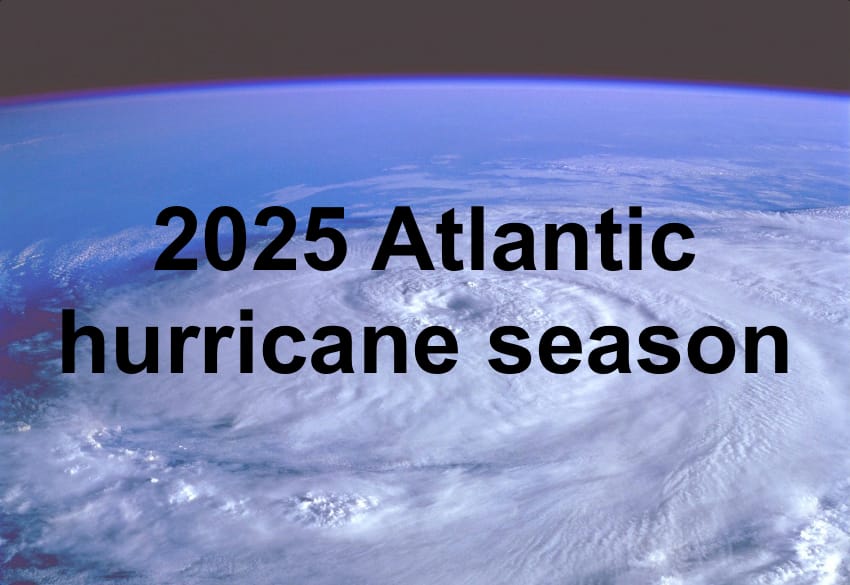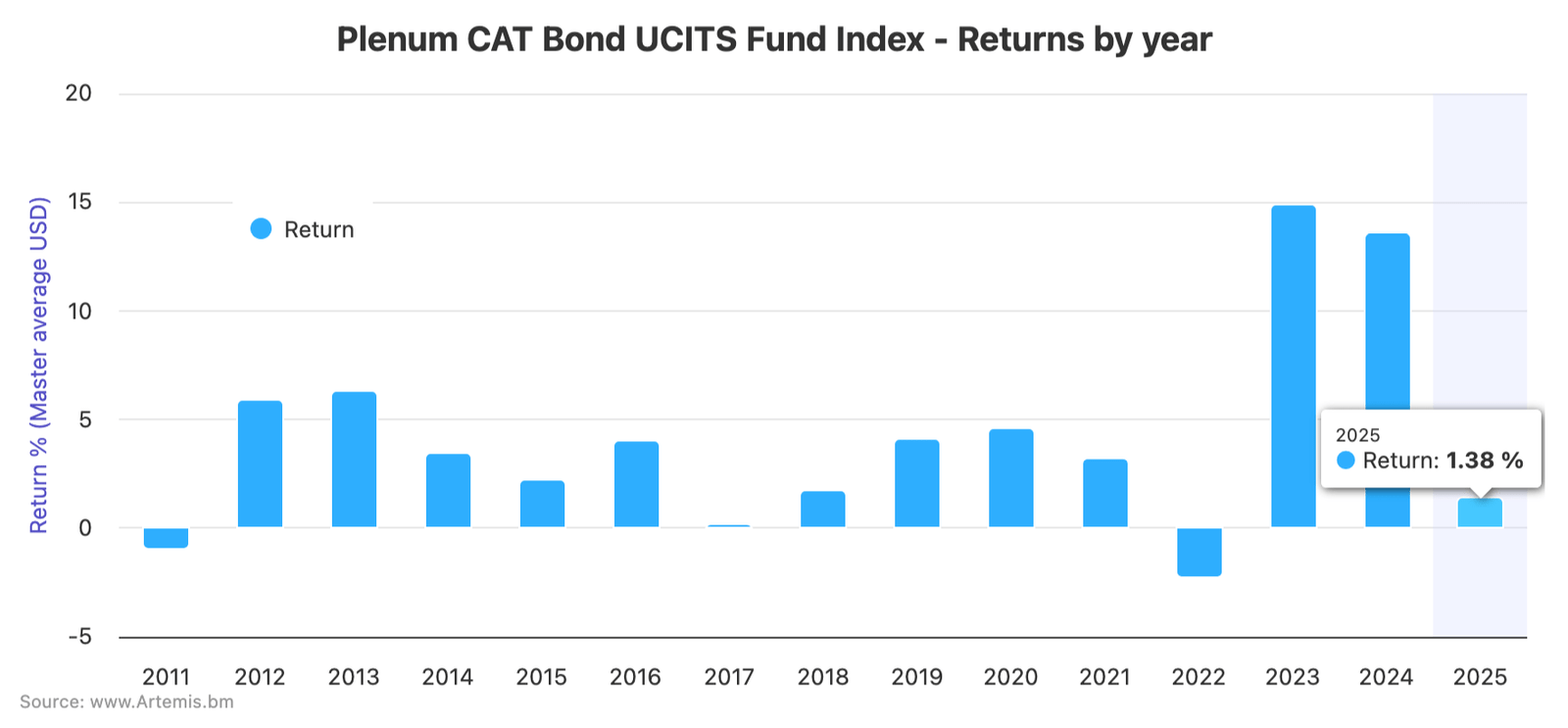This content is copyright to www.artemis.bm and should not appear anywhere else, or an infringement has occurred.
There are now a number of long-range forecasts available for the upcoming 2025 Atlantic hurricane season and between them the indication is that meteorologists are anticipating a season about in-line with the recent historical ten-year average.
 The latest forecast released today by the Colorado State University (CSU) tropical meteorology forecast team calls for 17 named tropical storms to form during the 2025 hurricane season in the Atlantic, which runs from June 1st to November 30th.
The latest forecast released today by the Colorado State University (CSU) tropical meteorology forecast team calls for 17 named tropical storms to form during the 2025 hurricane season in the Atlantic, which runs from June 1st to November 30th.
The CSU forecast team forecasts that there could be up to 9 hurricanes during the 2025 Atlantic storm season, with as many as 4 reaching major hurricane strength at Category 3 or higher.
While we know there are some in the insurance and reinsurance industry, as well as in catastrophe bonds and insurance-linked securities (ILS), that find the earlier seasonal forecasts a less accurate predictor of hurricane activity levels, they are a useful indicator for the meteorological conditions that could be seen, based on the data as of the forecast date.
The CSU forecast team said, “We anticipate that the 2025 Atlantic basin hurricane season will have above-normal activity. Current La Niña conditions are likely to transition to ENSO neutral conditions in the next couple of months; however, there remains considerable uncertainty as to what the phase of ENSO will be this summer and fall.
“Sea surface temperatures across the eastern and central Atlantic are generally warmer than normal, but not as warm as they were last year at this time. A warmer-than-normal tropical Atlantic combined with likely ENSO neutral (or potential La Niña) conditions typically provides a more conducive dynamic and thermodynamic environment for hurricane formation and intensification”
The CSU team also comment on landfall probabilities, from their early April hurricane season outlook, “We anticipate an above-average probability for major hurricanes making landfall along the continental United States coastline and in the Caribbean. As with all hurricane seasons, coastal residents are reminded that it only takes one hurricane making landfall to make it an active season. Thorough preparations should be made every season, regardless of predicted activity.”
The forecast for storm numbers are above the 1991 to 2020 average, but relatively closely aligned with the ten-year average of the most recent seasons. See some of these averages on our 2025 Atlantic hurricane season page.
The CSU forecast team give, as of early April, a 51% probability for a major Category 3 or greater hurricane making landfall in the United States, which is above the long-term historical average of 43%.
They also give a 26% probability for a major Category 3 or greater hurricane making landfall on the east coast of the United States including Florida, which is again above the long-term historical average of 21%.
For the Gulf Coast, they give a 33% probability for a major Category 3 or greater hurricane making landfall, which is above the long-term historical average of 27%.
The probability of a major hurricane tracking through the Caribbean during the 2025 tropical storm season is given as 56%, again higher than the long-term average of 47%.
For comparison, back in December, Tropical Storm Risk (TSR) projected there could be 15 named storms, 7 hurricanes and 3 major hurricanes in the 2025 hurricane season, which would be roughly aligned with the 30-year norm. TSR is due to put out a forecast update later this month.
Meanwhile, Accuweather has forecasted between 13 and 18 named tropical storms, between 7 and 10 hurricanes and between 3 and 5 major hurricanes for the 2025 season.
Accuweather also suggest there could be between 3 and 6 direct US impacts during the 2025 Atlantic tropical storm season.
This forecaster warns of the potential for tropical storms to form before June 1st and for there to be activity early season, followed by a lull and then being capped off by a busy end to the hurricane season in 2025.
“Similar to last year, northern and eastern portions of the Gulf Coast and the Carolinas are at a higher-than-average risk of direct impacts this season,” AccuWeather Lead Hurricane Expert Alex DaSilva explained. “Atlantic Canada and the northeastern Caribbean are also at an increased risk of direct impacts.”
“A rapid intensification of storms will likely be a major story yet again this year as sea-surface temperatures and ocean heat content (OHC) across most of the basin are forecast to be well above average,” DaSilva also said.
“A trend toward a La Niña could yield an active end to the season, while a trend toward El Niño could lead to an earlier end to the season,” DaSilva added.
There has also been an early 2025 hurricane season forecast issued by Weatherbell, another firm that has been used by insurance and reinsurance industry participants over the years.
Weatherbell said that, based on its early analysis, the 2025 hurricane season should have fewer impacts than 2024, with 2018 being the closest analog year it sees.
This company said that, in its view, there are no clear landfall signals for the coming 2025 hurricane season, while also saying that even if El Niño develops it likely won’t be a huge factor.
Weatherbell calls for between 15 and 19 named storms, from 7 to 9 hurricanes and 2 to 3 major hurricanes during the 2025 Atlantic storm season, but notes that true tropical cyclones could be fewer but the numbers bumped up by storms in the North Atlantic.
Across the forecasts in so far, the average suggests 17 named storms, 8 hurricanes and 3 major hurricanes for the 2025 Atlantic tropical storm season, which is just slightly below the recent 10-year average experience.
It is very early and no conclusions should be drawn from these April and earlier hurricane season forecasts for the Atlantic basin.
We’ll update over the coming months as later forecasts come out. As ever, confidence in forecasts rises as the start of the season nears.
It’s worth noting that a study from insurance-linked securities (ILS) manager Euler ILS Partners and Tropical Storm Risk (TSR) last year concluded that the July forecast, just at the start of the hurricane season, can provide a useful input to reinsurance portfolio and hedging decision making for insurance-linked securities (ILS) funds.
Track the 2025 Atlantic tropical storm and hurricane season on our dedicated page and we’ll update you as new information emerges.
Early 2025 hurricane forecasts suggest seasonal activity aligned with 10-year average was published by: www.Artemis.bm
Our catastrophe bond deal directory
Sign up for our free weekly email newsletter here.
This content is copyright to www.artemis.bm and should not appear anywhere else, or an infringement has occurred.
There are now a number of long-range forecasts available for the upcoming 2025 Atlantic hurricane season and between them the indication is that meteorologists are anticipating a season about in-line with the recent historical ten-year average.
 The latest forecast released today by the Colorado State University (CSU) tropical meteorology forecast team calls for 17 named tropical storms to form during the 2025 hurricane season in the Atlantic, which runs from June 1st to November 30th.
The latest forecast released today by the Colorado State University (CSU) tropical meteorology forecast team calls for 17 named tropical storms to form during the 2025 hurricane season in the Atlantic, which runs from June 1st to November 30th.
The CSU forecast team forecasts that there could be up to 9 hurricanes during the 2025 Atlantic storm season, with as many as 4 reaching major hurricane strength at Category 3 or higher.
While we know there are some in the insurance and reinsurance industry, as well as in catastrophe bonds and insurance-linked securities (ILS), that find the earlier seasonal forecasts a less accurate predictor of hurricane activity levels, they are a useful indicator for the meteorological conditions that could be seen, based on the data as of the forecast date.
The CSU forecast team said, “We anticipate that the 2025 Atlantic basin hurricane season will have above-normal activity. Current La Niña conditions are likely to transition to ENSO neutral conditions in the next couple of months; however, there remains considerable uncertainty as to what the phase of ENSO will be this summer and fall.
“Sea surface temperatures across the eastern and central Atlantic are generally warmer than normal, but not as warm as they were last year at this time. A warmer-than-normal tropical Atlantic combined with likely ENSO neutral (or potential La Niña) conditions typically provides a more conducive dynamic and thermodynamic environment for hurricane formation and intensification”
The CSU team also comment on landfall probabilities, from their early April hurricane season outlook, “We anticipate an above-average probability for major hurricanes making landfall along the continental United States coastline and in the Caribbean. As with all hurricane seasons, coastal residents are reminded that it only takes one hurricane making landfall to make it an active season. Thorough preparations should be made every season, regardless of predicted activity.”
The forecast for storm numbers are above the 1991 to 2020 average, but relatively closely aligned with the ten-year average of the most recent seasons. See some of these averages on our 2025 Atlantic hurricane season page.
The CSU forecast team give, as of early April, a 51% probability for a major Category 3 or greater hurricane making landfall in the United States, which is above the long-term historical average of 43%.
They also give a 26% probability for a major Category 3 or greater hurricane making landfall on the east coast of the United States including Florida, which is again above the long-term historical average of 21%.
For the Gulf Coast, they give a 33% probability for a major Category 3 or greater hurricane making landfall, which is above the long-term historical average of 27%.
The probability of a major hurricane tracking through the Caribbean during the 2025 tropical storm season is given as 56%, again higher than the long-term average of 47%.
For comparison, back in December, Tropical Storm Risk (TSR) projected there could be 15 named storms, 7 hurricanes and 3 major hurricanes in the 2025 hurricane season, which would be roughly aligned with the 30-year norm. TSR is due to put out a forecast update later this month.
Meanwhile, Accuweather has forecasted between 13 and 18 named tropical storms, between 7 and 10 hurricanes and between 3 and 5 major hurricanes for the 2025 season.
Accuweather also suggest there could be between 3 and 6 direct US impacts during the 2025 Atlantic tropical storm season.
This forecaster warns of the potential for tropical storms to form before June 1st and for there to be activity early season, followed by a lull and then being capped off by a busy end to the hurricane season in 2025.
“Similar to last year, northern and eastern portions of the Gulf Coast and the Carolinas are at a higher-than-average risk of direct impacts this season,” AccuWeather Lead Hurricane Expert Alex DaSilva explained. “Atlantic Canada and the northeastern Caribbean are also at an increased risk of direct impacts.”
“A rapid intensification of storms will likely be a major story yet again this year as sea-surface temperatures and ocean heat content (OHC) across most of the basin are forecast to be well above average,” DaSilva also said.
“A trend toward a La Niña could yield an active end to the season, while a trend toward El Niño could lead to an earlier end to the season,” DaSilva added.
There has also been an early 2025 hurricane season forecast issued by Weatherbell, another firm that has been used by insurance and reinsurance industry participants over the years.
Weatherbell said that, based on its early analysis, the 2025 hurricane season should have fewer impacts than 2024, with 2018 being the closest analog year it sees.
This company said that, in its view, there are no clear landfall signals for the coming 2025 hurricane season, while also saying that even if El Niño develops it likely won’t be a huge factor.
Weatherbell calls for between 15 and 19 named storms, from 7 to 9 hurricanes and 2 to 3 major hurricanes during the 2025 Atlantic storm season, but notes that true tropical cyclones could be fewer but the numbers bumped up by storms in the North Atlantic.
Across the forecasts in so far, the average suggests 17 named storms, 8 hurricanes and 3 major hurricanes for the 2025 Atlantic tropical storm season, which is just slightly below the recent 10-year average experience.
It is very early and no conclusions should be drawn from these April and earlier hurricane season forecasts for the Atlantic basin.
We’ll update over the coming months as later forecasts come out. As ever, confidence in forecasts rises as the start of the season nears.
It’s worth noting that a study from insurance-linked securities (ILS) manager Euler ILS Partners and Tropical Storm Risk (TSR) last year concluded that the July forecast, just at the start of the hurricane season, can provide a useful input to reinsurance portfolio and hedging decision making for insurance-linked securities (ILS) funds.
Track the 2025 Atlantic tropical storm and hurricane season on our dedicated page and we’ll update you as new information emerges.
Early 2025 hurricane forecasts suggest seasonal activity aligned with 10-year average was published by: www.Artemis.bm
Our catastrophe bond deal directory
Sign up for our free weekly email newsletter here.





